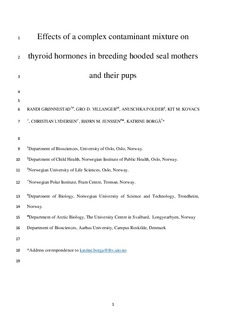| dc.contributor.author | Grønnestad, Randi | |
| dc.contributor.author | Villanger, Gro Dehli | |
| dc.contributor.author | Polder, Anuschka | |
| dc.contributor.author | Kovacs, Kit M. | |
| dc.contributor.author | Lydersen, Christian | |
| dc.contributor.author | Jenssen, Bjørn Munro | |
| dc.contributor.author | Borgå, Katrine | |
| dc.date.accessioned | 2019-05-02T07:39:45Z | |
| dc.date.available | 2019-05-02T07:39:45Z | |
| dc.date.created | 2018-07-03T11:09:51Z | |
| dc.date.issued | 2018 | |
| dc.identifier.citation | Environmental Pollution. 2018, 240 10-16. | nb_NO |
| dc.identifier.issn | 0269-7491 | |
| dc.identifier.uri | http://hdl.handle.net/11250/2596231 | |
| dc.description.abstract | There is a general lack of information on the possible effects of perfluoroalkyl substances (PFASs) on thyroid hormones (THs) in wildlife species. The effects of PFASs, which are known endocrine disruptors, on the TH homeostasis in hooded seals (Cystophora cristata) have yet to be investigated. Previously, correlations were found between plasma thyroid hormone (TH) concentrations in hooded seals, and organohalogen contaminants (OHCs) and hydroxyl (OH)-metabolites. Because animals are exposed to multiple contaminants simultaneously in nature, the effects of the complex contaminant mixtures that they accumulate should be assessed. Herein, we analyse relationships between plasma concentrations of multiple contaminants including protein-associated PFASs, hydroxylated metabolites of polychlorinated biphenyls (OH-PCBs) and lipid soluble OHCs and plasma concentrations of free and total THs, i.e. triiodothyronine (FT3, TT3) and thyroxine (FT4, TT4) in hooded seal mothers and their pups. The perfluoroalkyl carboxylates (PFCAs) were the most important predictors for FT3 concentrations and TT3:FT3 ratios in the mothers. The FT3 levels decreased with increasing PFCA levels, while the TT3:FT3 ratios increased. In the pups, hexachlorocyclohexanes (HCHs) were the most important predictors for TT3:FT3 ratios, increasing with increasing HCHs levels. Additionally, perfluoroalkyl sulfonates (PFSAs) and PFCAs were important predictors for FT4:FT3 ratios in hooded seal pups, and the ratio increased with increasing concentrations. The study suggests that PFASs contribute to thyroid disruption in hooded seals exposed to complex contaminant mixtures that include chlorinated and fluorinated organic compounds. | nb_NO |
| dc.language.iso | eng | nb_NO |
| dc.publisher | Elsevier | nb_NO |
| dc.rights | Attribution-NonCommercial-NoDerivatives 4.0 Internasjonal | * |
| dc.rights | Attribution-NonCommercial-NoDerivatives 4.0 Internasjonal | * |
| dc.rights.uri | http://creativecommons.org/licenses/by-nc-nd/4.0/deed.no | * |
| dc.rights.uri | http://creativecommons.org/licenses/by-nc-nd/4.0/deed.no | * |
| dc.title | Effects of a complex contaminant mixture on thyroid hormones in breeding hooded seal mothers and their pups | nb_NO |
| dc.type | Journal article | nb_NO |
| dc.type | Peer reviewed | nb_NO |
| dc.description.version | acceptedVersion | nb_NO |
| dc.source.pagenumber | 10-16 | nb_NO |
| dc.source.volume | 240 | nb_NO |
| dc.source.journal | Environmental Pollution | nb_NO |
| dc.identifier.doi | 10.1016/j.envpol.2018.04.052 | |
| dc.identifier.cristin | 1595383 | |
| dc.description.localcode | © 2018. This is the authors’ accepted and refereed manuscript to the article. Locked until 3.5.2020 due to copyright restrictions. This manuscript version is made available under the CC-BY-NC-ND 4.0 license http://creativecommons.org/licenses/by-nc-nd/4.0/ | nb_NO |
| cristin.unitcode | 194,66,10,0 | |
| cristin.unitname | Institutt for biologi | |
| cristin.ispublished | true | |
| cristin.fulltext | preprint | |
| cristin.qualitycode | 1 | |

